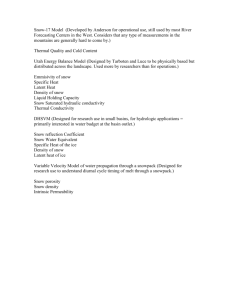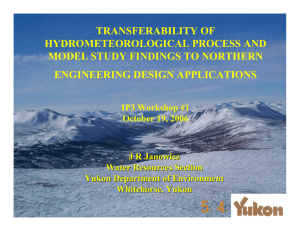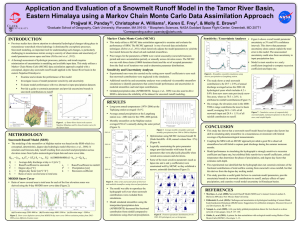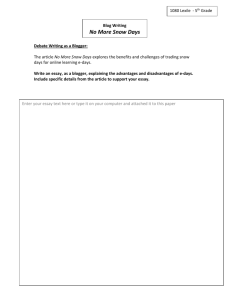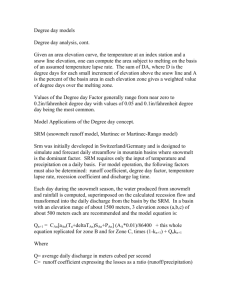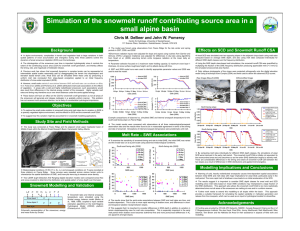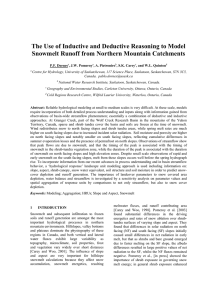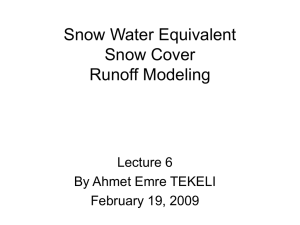abstract - UPCommons
advertisement
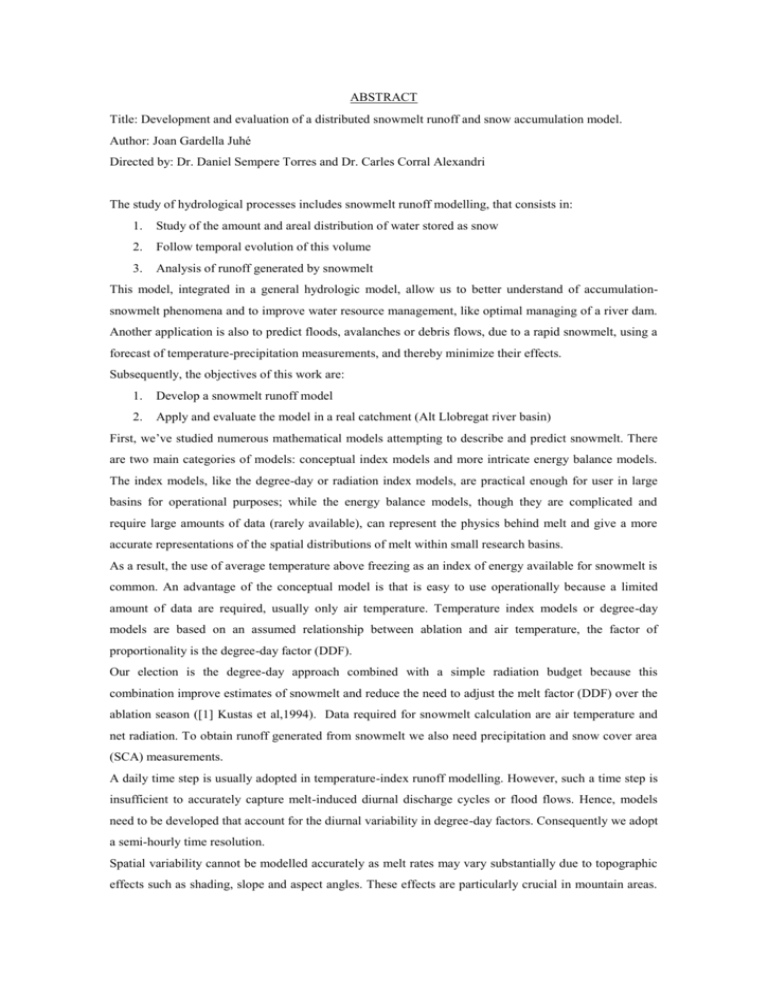
ABSTRACT Title: Development and evaluation of a distributed snowmelt runoff and snow accumulation model. Author: Joan Gardella Juhé Directed by: Dr. Daniel Sempere Torres and Dr. Carles Corral Alexandri The study of hydrological processes includes snowmelt runoff modelling, that consists in: 1. Study of the amount and areal distribution of water stored as snow 2. Follow temporal evolution of this volume 3. Analysis of runoff generated by snowmelt This model, integrated in a general hydrologic model, allow us to better understand of accumulationsnowmelt phenomena and to improve water resource management, like optimal managing of a river dam. Another application is also to predict floods, avalanches or debris flows, due to a rapid snowmelt, using a forecast of temperature-precipitation measurements, and thereby minimize their effects. Subsequently, the objectives of this work are: 1. Develop a snowmelt runoff model 2. Apply and evaluate the model in a real catchment (Alt Llobregat river basin) First, we’ve studied numerous mathematical models attempting to describe and predict snowmelt. There are two main categories of models: conceptual index models and more intricate energy balance models. The index models, like the degree-day or radiation index models, are practical enough for user in large basins for operational purposes; while the energy balance models, though they are complicated and require large amounts of data (rarely available), can represent the physics behind melt and give a more accurate representations of the spatial distributions of melt within small research basins. As a result, the use of average temperature above freezing as an index of energy available for snowmelt is common. An advantage of the conceptual model is that is easy to use operationally because a limited amount of data are required, usually only air temperature. Temperature index models or degree-day models are based on an assumed relationship between ablation and air temperature, the factor of proportionality is the degree-day factor (DDF). Our election is the degree-day approach combined with a simple radiation budget because this combination improve estimates of snowmelt and reduce the need to adjust the melt factor (DDF) over the ablation season ([1] Kustas et al,1994). Data required for snowmelt calculation are air temperature and net radiation. To obtain runoff generated from snowmelt we also need precipitation and snow cover area (SCA) measurements. A daily time step is usually adopted in temperature-index runoff modelling. However, such a time step is insufficient to accurately capture melt-induced diurnal discharge cycles or flood flows. Hence, models need to be developed that account for the diurnal variability in degree-day factors. Consequently we adopt a semi-hourly time resolution. Spatial variability cannot be modelled accurately as melt rates may vary substantially due to topographic effects such as shading, slope and aspect angles. These effects are particularly crucial in mountain areas. Elevation bands are often the only criterion for spatial discretisation. Hence, melt rates will only vary as a function of elevation resulting from an air temperature lapse rate. Therefore we present a distributed grid based model with 45m spatial resolution. The inclusion of potential direct solar radiation into temperature index models can improve traditional methods with respect to spatial distribution and also diurnal variation in melt rates, without need for more data ([2] Hock, 2003). Model uses interpolated air temperature and precipitation fields obtained from weather stations. Because radiation measurements are not often available to maintain a high operational capability under a variety of atmospheric conditions and terrain configurations without the need for extensive measurements, a simple model for simulating shortwave and longwave components of the radiation balance that requires minimal information was developed. Because of it topographic effects on snowpack available energy are accounted. Remember that snowmelt depends, at a point scale, on available energy, which in turn is heavily affected by slope, aspect and shading effects of the site ([3] Cazorzi et al, 1996). A necessary ingredient in snow runoff analysis is determining the quantity and distribution of snow -more specifically the snow water equivalent (SWE) - that exists in the basin. The model accumulates snowmelt for each cell (45mx45m) using a temperature threshold. Finally, to validate the model (second objective), we apply it in the Alt Llobregat river basin (located in Catalunya) and two different ways of validation are adopted: (1) computed hourly snowmelt rates and runoff generated for an ablation period were compared with observed outflow hydrograph, and (2) produced snow water equivalent maps were compared with snow cover satellite maps of the site. We’ve to take into account that the results are a first tentative, then we can’t conclude rotundity the goodness of the model. The results showed that: 1. The model is computationally efficient for rapid simulations. 2. This model simulates the topographic controls on snow deposition and melt, during both the development of the seasonal snow cover in winter, and the ablation of the snow cover during spring and early summer. Because of high spatial resolution and the inclusion of radiation balance into temperature index model. 3. The incorporation of snow process models like refreezing of meltwater, water retention capacity and cold content of snowpack improve the results, delaying the release of meltwater. 4. The maps of snow cover simulated in this study are in agreement with the observed data. There is evidence that the model captures the spatial variability of snow cover. Although this concordance with observations, the model still needs to be tested over a wide range of cases. 5. The complexity of modelling water flux in snow and the poor quality of the hydrograph data make uncertain result comparison. Although we can observe a good agreement of peak discharges. 6. By integrating simulated streamflow and comparing this snowmelt-runoff volume with observed streamflow we obtain an underestimation, possibly due to inadequate precipitation data.


